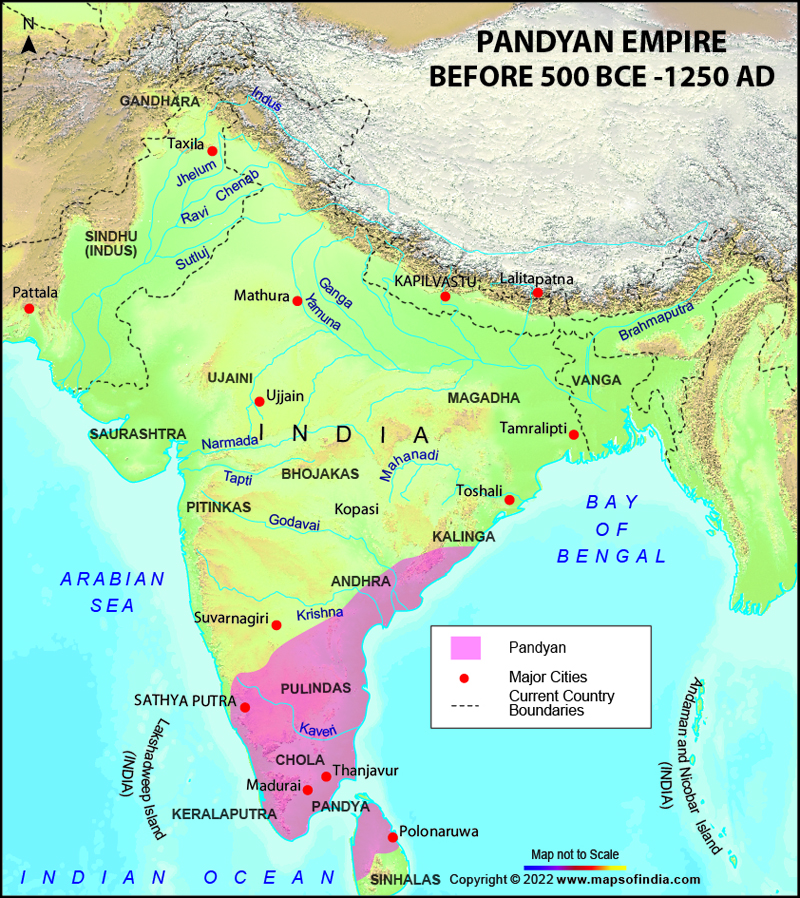One of the three famous ancient Tamil dynasties (other two being Chola and Chera), the Pandyan dynasty ruled several parts of the Southern India until the 15th century CE. Their main capital was Korkai, from where they ruled their country Pandya Nadu. Korkai was a seaport situated on the southernmost tip of the Indian Peninsula. Later it was moved to Madurai.
Origin of the Pandyans
It is believed that the Dhravidians must have penetrated into the southern part of the country in about 700 BC and organized developed themselves into distinguishable sects. The existence of such a community can be justified with titles such as Solan, Pandiyan, and Keralas. Initially in the first century AD, the Pandyan Kingdom consisted of only the greater part of modern Madura and the district of Tinnevelly.
It was in the beginning of the thirteenth century AD that the famous Marco Polo tagged this dynasty as the richest existing empire. During the Pandyan Empire a great development in the architecture was seen with the construction and inauguration of many temples, some of which are Meenakshi Amman Temple in Madurai and Nellaiappar Temple, located on the bank of the river Thamirabarani in Tirunelveli.
Rulers of the Pandyan Dynasty
Jatavarman or Maravarman Pandyan was generally the names of the Pandyan Kings. Earlier they were believed to be Jains but after a few centuries of rule they became Shaivaits. Cheras were the allies of Pandyas for a long time as compared to the Cholas. Only due to their dependence with Cholas and Cheras they could continue free movement and carry out trade along the coast of Sri Lanka.
The Pandyan dynasty expanded at a great pace. Its power spread over Kerala, the southwestern part of India and Sri Lanka. The expansion happened during the rule of kings like Kadungon (590-620), Arikesar Maravarman (670-700), Varagunamaharaja I (765-815), and Srimara Srivallabha (815-862). Some other Pandya kings were:
- Koon Pandiyan
- Mudukudumi Paruvaludhi
- Nedunj Cheliyan I (Aariyap Padai Kadantha Nedunj Cheliyan)
- Nedunj Cheliyan II
- Kadalan valuthi
- Nan Maran
- Kadalul Maintha Ukkirap Peruvaludi
- Nedunj Cheliyan III (Talaiyaalanganathu Seruvendra Nedunj Cheliyan)
- Maran Valudi
- Musiri Mutriya Cheliyan
- Pudappandiyan
Fall of the Pandyans
It was in 1311 that Madurai was invaded by the Delhi Sultanate forces that the conditions of the Pandyans worsen and they turned into mere local rulers. At the time of the invasion of the Kalabhras, the Pandyans, as of the Sangam literature marched into complete obscurity.
It was in about 940 AD, that the Chola king Rajaraja reduced the Pandyas to tributary dependence which lasted for about the following two centuries. The Cholas dominating rule brought in a number of kings and emperors to rule the once powerful Pandyan Kingdom, such as Madura Sultans, Vijayanagara Rayas, Nayakas of Madura, Nawabs of Arcot. Towards the end of the sixteenth century, the Pandyan dynasty suddenly disappeared from Indian historical scene forever.
Last Updated on : November 13, 2025

